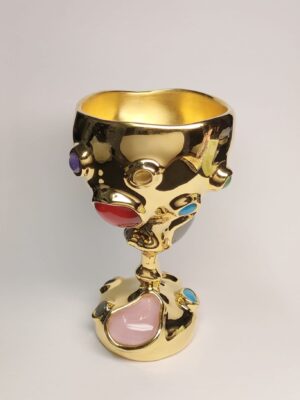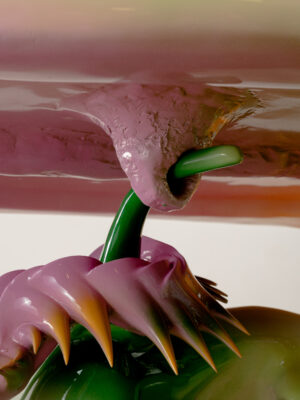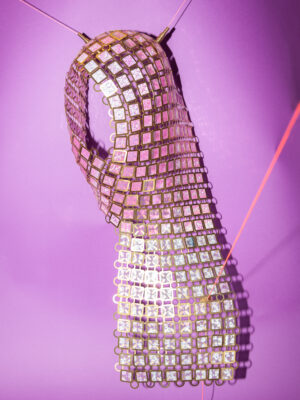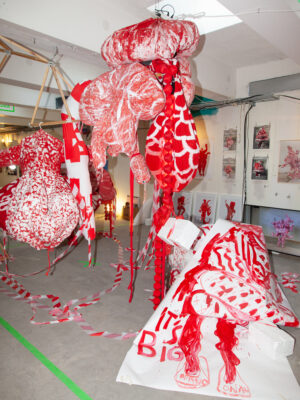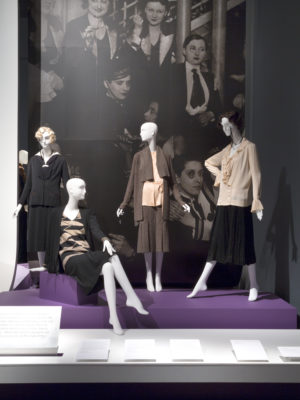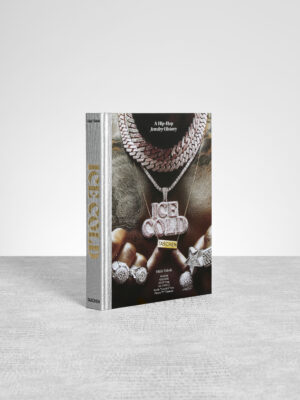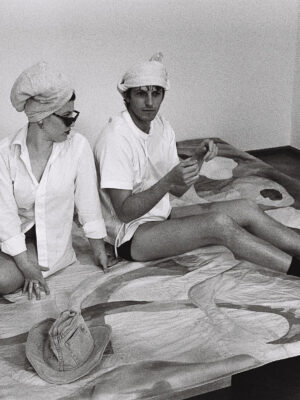
So, imagine: you are finally awake on a sunny morning sometime in a distant future in your palatial home. You find yourself surrounded by objects brimming with agency. I don’t mean virtual assistants or talking fridges, or nano drones and artificial intelligence stuff. I’m talking about objects that trace and reflect the changes in, say, socio-political and ecological debates, and transform not just themselves, but the idea of themselves through their materiality and manifestation.
___STEADY_PAYWALL___
You look around: things have surely changed in the past ahem-ahem years. Serving one master and one purpose are no longer expected assignments; things got weirder, a lot weirder. As you finish your morning coffee, you glance out the window into the garden where an assembly line robot who prefers to be called Røbopièrreis taking some leisure time to gently paint en plein air. You pass by the entertainment area where the ASMR ‘pleasure’ objects, designed for gentle physical stimulation greet you with a little hum and a wobble. At last, you make your way into the apparating room—a private space commonly used by the house dwellers of the future—to disappear into the digital realm.
At this very moment, the museum Villa Stuck in Munich—the former home and studio of the famous German painter Franz von Stuck—is transformed into a house of the future. An effervescent mix of classical architecture, art nouveau opulent interiors, and Misha Kahn’s knotted, tangled furniture is being served under the sauce of fictional stories co-written by Kahn and curator Kellie Riggs. Their version of the future is far from the stark techie sci-fi firmly hammered into our collective consciousness by Hollywood. They offer an alternative one: a place where the Metaverse arises as the origin of voluptuous decadent aesthetics that mean everything and nothing, where functionality questions itself, and then declares itself irrelevant.
Kahn and Riggs propose a timeline when and where humans use objects that ‘do splits’ (2) between digital connectedness and physical isolation–‘paragons of the time in that their being articulates a specific push and pull of reason. They wrestle with order, and wonder, and confusion, as we all have.
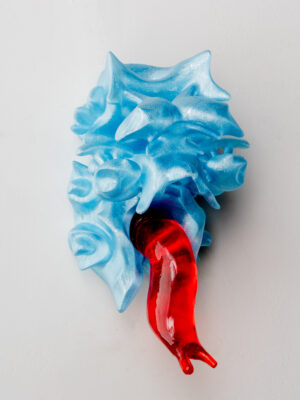
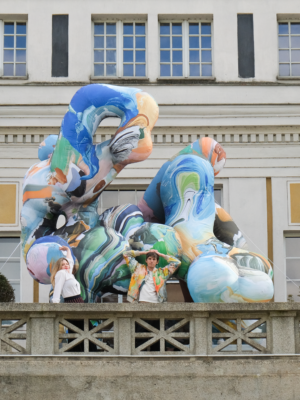
‘They offer an alternative one: a place where the Metaverse arises as the origin of voluptuous decadent aesthetics that mean everything and nothing, where functionality questions itself, and then declares itself irrelevant.’
Let’s take a house tour, shall we?
Born in 1989, in Duluth Minnesota, Misha Kahn is a young American artist, sculptor and furniture designer extra-extraordinaire. A few years ago, when I first met him in New York, he had already been included in the Forbes 30 under30 Art & Style list, exhibited at the Whitney in New York, made commissioned pieces for Dior, was given a carte-blanche by one of the world’s most powerful design galleries Friedman Benda, and had already sold out several exhibition sunder his, undoubtedly, exquisite brand belt. At the time, Misha had just completed a design for his first ‘fine’ jewellery piece: a bean-shaped titanium miniature pachinko (3) ring. Discussing the materials, he pointed out to me that he was planning to add small ruby spheres to roll around a labyrinth under a hand-carved dome made of crystal rock. The ring was to be made in collaboration with one of Italy’s finest jewellers, Gian Carlo Montebello, a man behind artists’ jewellery by the likes of Lucio Fontana, Hans Richter, and, for the longest time, Man Ray. I gasped (and gagged!) at the way the exquisiteness of materials, techniques, and the calibre of the people involved were at complete odds with the nonsensical whimsical nature of the ring (I believe the price was also quite jaw-dropping, I can’t quite recall, I might have blacked out at that point).
It was the contrast of the American pop culture sugar-high simplicity with the incredible complexity of execution that really got me. We talked about how the ‘jewellery world’ would react to such a piece, and Kahn wondered what it would feel like to ‘win in jewellery’: to not only be very good in your own discipline, but to raise the bar in an entirely different field. His words popped into my head when I was shown the two other pieces of jewellery he developed for this exhibition. Made in close collaboration with the Italian master jeweller Matteo Bonafede, this brooch and a wrist watch are two absolute pieces of art, where the brakes are off, both in terms of technical skill and artistic imagination.
Under an almost unreal candy-purple amethyst dome is yet another miniature universe of gold and silver labyrinths, with sapphire and ruby spheres swiftly rolling in and out of the metal tubes. The overall shape could be called organic, yet it definitely has a ‘device’ feel to it. Intuitively, you know how to hold it in your hand; its geometry also nudges you to where the top or bottom of the piece are located. With uncanny skill, Matteo Bonafede was able to create a ball bearing system that allows the front part of the brooch to rotate around the backing by means of precious gem spheres that are precisely, down to a micron, identical. Without it, the mechanism wouldn’t work!
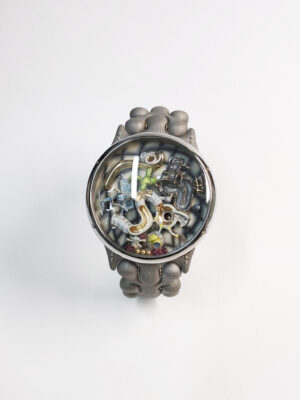
The second jewellery piece is a massive wrist watch that isn’t a watch at all. With this piece, Kahn imagined an absolute Versailles labyrinth, encapsulated in a micro pachinko-like world. In the distant future, according to Kahn, the cellular, mobile device craze will pass (whew, right!?) Instead of fidgeting with your phone while waiting for a friend to show up, people will begin to buy exquisite time-passing devices such as this one, executed in gold, crystal rock, titanium and free moving ruby and sapphire spheres. The fictional text accompanying this work reads:
‘…Coinciding with this technology was the newfound philosophy of “Time Internal Eternal” – a departure from the fixed march of the clock towards an inward understanding of the fickle passing of hours, days and seasons. This new relationship to time meant that simple meetings could result in waiting exceptionally long stretches for someone to arrive, and therefore a willingness to invest a small fortune into the precious apparatuses became normalised.’
It looks like the future clock will tick differently for everyone…
‘It’s like no-one ever told Misha that he isn’t allowed to do something, that something was not allowed. He is like a child that walks around the room and just grabs everything and puts it together. Unafraid.’
The curves and the swelling lines of Kahn’s designs continue to flow out of the miniature world of jewellery and spill into sculptures, paintings, tapestries, cabinets and more. His highly associative and daring mind is able to connect the material, formal, methodological ‘dots’ with virtuosity and seamlessness. There’s something about Kahn’s work, that when you see it you know it’s his by how unabashedly it begins a dialog with you, taps into your memories, gets under your skin, claims a space in your mind and sets up camp.
‘Under the Wobble Moon. Objects from the Capricious Age’ also materialised as a series of fictional stories that I quote here to draw special attention to them. This playful dialogue between Misha Kahn and Kellie Riggs — independent curator, writer, jeweller, and the artists’ best friend, is part of the relationship that takes a front and central seat in this show.
Instant friends and roommates back at Rhode Island School of Design in the late 00s, Kahn and Riggs founded a student-run gallery, Exposé, that ran for about a decade after their departure. Putting together shows, parties, photoshoots back then, and working together continuously in later years (Kahn helped design furniture for Riggs’ 2019 exhibition ‘Non-Stick Nostalgia’ at the Museum of Art and Design in NYC, and Riggs project-manages Kahn’s Italy based projects) — this is a friendship of two people amplifying each other, taking next steps together, and constantly pushing each other creatively.
Considering the above, I obviously jumped at a chance to spend a couple of days in Munich while the exhibition was being set up. After the first look, accompanied by the curator showing me around, I couldn’t always tell what materials and techniques were being used. Everything seemed in motion and afloat, as if a tentacle-like table leg was about to crawl up and tap me on the shoulder. It felt unreal, animated.
I mentioned this feeling to Riggs and she said, looking around herself: ‘It’s like no-one ever told Misha that he isn’t allowed to do something, that something was not allowed. He is like a child that walks around the room and just grabs everything and puts it together. Unafraid.’ This reminded me of a metaphor used by the astrophysicist Abel Lawrence Peirson about machine learning. He made that exact same comparison. He saw Artificial Intelligence as a child that will learn about its environment by tirelessly taking things apart and putting them together — by creating infinite possibilities. Perhaps, Kahn’s genuine interest in technology has something to do with this unbounded approach. During one of the first ‘house tours’, after watching the Røbopièrre paint, someone had asked him if a computer (robot) could ever replace an artist. To that he answered, with a dose of sarcasm, no, why do people always want to focus on humanising machines! His patient attempts at a dialogue with technology, however, speaks of a slightly more complex relationship, and perhaps, a sense of anticipation. Remember, he dedicated a sizeable part of the exhibition to a project that involves programming a robotic arm to paint. In collaboration with a Poland based programmer Filip Bielicki, Misha’s complex, layered, Oculus haptic 3D paintings were interpreted into simpler vector drawings, and then into a series of tens of thousands commands for the robot to follow. The outcome? Røbopièrre’s meditatively gentle gestures, as she carefully opens custom-made paint jars and chooses a specific brush out of the three she has at her disposal, fitted into her spinning claw. She knows how to interpret the surface of the canvas, its size, which colour and brush stroke to choose next. Perhaps, the question about replacing the artist is not about the ‘if’, but more, under what set of conditions could we engage in a genuine dialogue with technology?
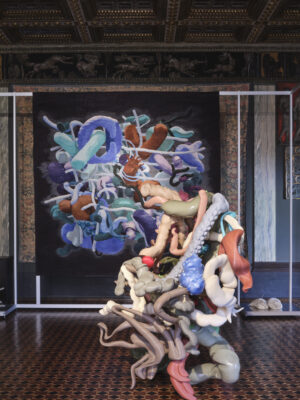
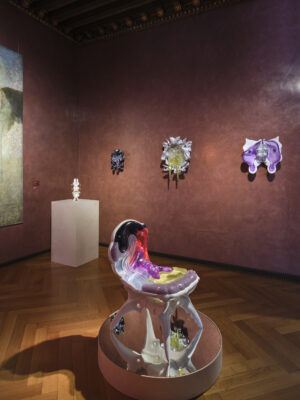
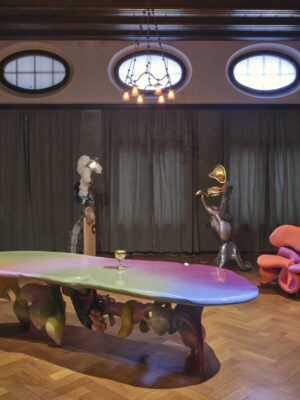
Coming back from the lavish gardens of Villa Stuck back into its voluptuous interiors. The dark and glistening Reception Room, or as Kahn has titled it, Bounty of Refuse room is perhaps the best exaple for how Kahn’s work fits in with the historic pieces. Here, the curatorial fiction loosely originates from a major cultural phenomenon (similar to the ‘wrist watch story’) which it then pushes off of the speculative edge. In the future, the so-called process of ‘particalization’– the text reads –
‘…method of breaking down trash into smaller and smaller pieces and distributing it evenly over the earth, was promoted by a government campaign during the Capricious Age. After its implementation, shredding parties came into vogue, and groups of friends would assemble to rip trash into small bits for the purpose of dispersing the shreds into rural areas and woods. The goal of the particalization campaign was to reach a trash stasis. At first, shredding was primarily an activity of the upper echelons, but the process became wildly popular after an aired concert series, ONE WORLD ONE DUMP. Thereafter, shredding became a daily fidget of wide swaths of society. As shredding grew in popularity, the elite sector turned to ‘scrappings’. Scrappings were a type of nature walk during which larger bits of only marginally shredded trash were collected; rarer still were the pure, untouched pieces like car parts and crumpled food containers… As most rubbish had been reduced to under a centimeter due to particalization, finding larger chunks was something of an enticing treasure hunt. Such specimens could fetch handsome sums at market even without being reworked into home furnishings…’
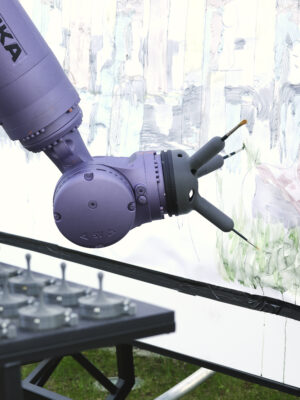
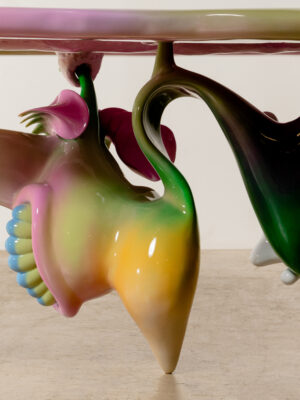
Once again, Kahn and Riggs take a socio-political issue, and push it to an absolute absurdity. Due to the intrinsic logic of how trends appear to work, the texts arrive at a conclusion that seems quite plausible. As the story progresses and the trash of the future finds its way back into objects like Kahn’s cabinets or lamps, they observe how an idea born out of a micro trend within society’s higher echelons becomes a cultural movement sweeping the masses. After this process, it is once more transformed to make its way back to the exclusive luxury market.
I wonder if Kahn is on to something with his ideas on the future of sensual gratification. The Asexual Sensualism room is his take on future ‘pleasure objects’:
‘As the phenomenon of ASMR (3) took its cultural hold, large populations consequently forwent physical arousal, no longer engaging in the custom of intercourse. Instead, less erotic activities meant to stimulate only the skin became the preferred standard, and objects were thus introduced to imitate the giving or receiving of tender, personal attention.’
The room showcases several objects, among which are the ‘feelers’ — softly glowing wall bra lamps. They combine hard and soft gel-like elements, with strong references to a human body. One could easily imagine being gently caressed by these wobbly tentacles. Being, however, presented as part of the guest entertainment rooms they may be telling us that the ‘behind-closed-doors’ aspect of sensual pleasures will be overcome in the future. It seems like our descendants will add collective moaning and the shivers due to tingling sensations as yet another item on the list of what friends do for fun.
Kahn’s deep knowing of the inner workings of the world, the ability to manifest the absurdity of humanity in its pursuits and failures while refraining from hardcore sarcasm or nihilism, but rather, lovingly observing — aren’t those the markings of a great mind able to see deep into the future, and deep into our collective psyche?
You’re finally awake, and as Misha Kahn once told me:
‘You have to leave space for your future self.’
